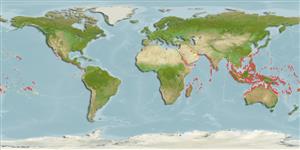>
Eupercaria/misc (Various families in series Eupercaria) >
Scaridae (Parrotfishes) > Scarinae
Etymology: Scarus: Greek, skaros = a fish described by anciente writers as a parrot fish; 1601 (Ref. 45335).
More on author: Forsskål.
Environment: milieu / climate zone / depth range / distribution range
Ecologie
marien rifbewoner; diepte 0 - 30 m (Ref. 128797). Tropical; 30°N - 27°S
Indo-Pacific: Red Sea south to Sodwana Bay, South Africa (Ref. 5490) and east to the Society Islands, north to the Ryukyu Islands, south to Shark Bay, Western Australia and the southern Great Barrier Reef.
Grootte / Gewicht / Leeftijd
Maturity: Lm ? range ? - ? cm
Max length : 44.4 cm TL mannelijk / geslacht onbekend; (Ref. 125599); max. gepubliceerd gewicht: 2.0 kg (Ref. 125599)
Dorsale stekels (totaal) : 9; Dorsale zachte stralen (totaal) : 10; Anale stekels: 3; Anale zachte stralen: 9. This species is distinguished by the following characters: median predorsal scales 6-8 (usually 7); 3 scale rows on cheek, 1(6-7), 2(6-9), 3(2-5); pectoral-fin rays 13-15 (usually 14); conical teeth on side, none in female, usually 2 on upper dental plate for terminal male; lips mainly covering dental plates; caudal fin rounded in small female, with prolonged lobes in large adult. Colour of male reddish brown anteriorly with red upper lip and dark bands around the mouth, greenish posteriorly with dark scale margins, the markings in the head variable but always with a dark-edged yellowish or bright green dot or spot at top end of line from mouth through eye to top of opercular opening.; female red on head, belly and fins, side with wavy black and white stripes, and dark green bands around mouth and eye (Ref. 9793, 90102).
Inhabits coral-rich areas of clear lagoons, channels, and outer reef slopes (Ref. 9710). Generally solitary (Ref. 1602). Juveniles in small groups on algae and coral reefs inshore (Ref. 48636). Feeds on benthic algae (Ref. 30573). Males maintain small harems and pair spawn (Ref. 1602).
Levenscyclus en paargedrag
Maturities | Voortplanting | Spawnings | Egg(s) | Fecundities | Larven
Oviparous, distinct pairing during breeding (Ref. 205).
Randall, J.E., G.R. Allen and R.C. Steene, 1990. Fishes of the Great Barrier Reef and Coral Sea. University of Hawaii Press, Honolulu, Hawaii. 506 p. (Ref. 2334)
Status op de Rode Lijst van het IUCN (Ref. 130435)
Gevaar voor de mens
Harmless
Gebruik door de mens
Visserij: commercieel; Aquarium: Commercieel
Tools
Speciale rapporten
Download XML
Internetbronnen
Estimates based on models
Preferred temperature (Ref.
123201): 24.9 - 29.3, mean 28.3 °C (based on 3475 cells).
Fylogenetische diversiteitsindex (Ref.
82804): PD
50 = 0.5000 [Uniqueness, from 0.5 = low to 2.0 = high].
Bayesian length-weight: a=0.01549 (0.01258 - 0.01907), b=3.04 (3.00 - 3.08), in cm total length, based on LWR estimates for this species (Ref.
93245).
Trofisch niveau (Ref.
69278): 2.0 ±0.0 se; based on diet studies.
Weerstandsvermogen (Ref.
120179): Hoog, minimale populatieverdubbelingstijd minder dan 15 maanden (K=0.37-0.72).
Fishing Vulnerability (Ref.
59153): Low vulnerability (23 of 100).
Nutrients (Ref.
124155): Calcium = 44.9 [29.2, 75.5] mg/100g; Iron = 0.832 [0.586, 1.273] mg/100g; Protein = 18.7 [16.6, 20.5] %; Omega3 = 0.0871 [, ] g/100g; Selenium = 19.2 [12.1, 30.0] μg/100g; VitaminA = 40.2 [12.3, 137.2] μg/100g; Zinc = 2.26 [1.71, 2.95] mg/100g (wet weight); based on
nutrient studies.
